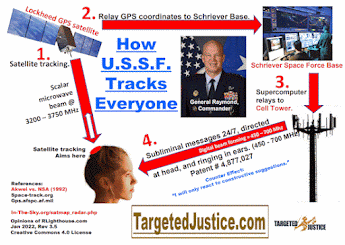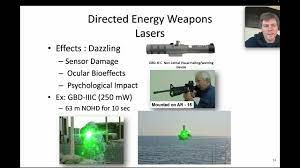Patent No. 5899922 Manipulation of nervous systems by electric fields
Patent No. 5899922
Manipulation of nervous systems by electric fields (Loos, May 4, 1999)
Abstract
Apparatus and method for manipulating the nervous system of a subject through afferent nerves, modulated by an externally applied weak electric field. The field frequency is to be chosen such that the modulation causes excitation of a sensory resonance. The resonances found so far include one near 1/2 Hz which affects the autonomic nervous system, and a resonance near 2.4 Hz that causes slowing of certain cortical processes. Excitation of the 1/2 Hz autonomic resonance causes relaxation, sleepiness, ptosis of the eyelids, or sexual excitement, depending on the precise frequency used. The weak electric field for causing the excitation is applied to skin areas away from the head of the subject, such as to avoid substantial polarization current densities in the brain. Very weak fields suffice for bringing about the physiological effects mentioned. This makes it possible to excite sensory resonances with compact battery powered devices that have a very low current consumption. The method and apparatus can be used by the general public as an aid to relaxation, sleep, or sexual arousal, and clinically for the control and perhaps the treatment of tremors and seizures, and disorders of the autonomic nervous system, such as panic attacks.
Notes:
SUMMARY
Experiments have shown that weak electric fields of frequency near 1/2 Hz applied
externally to the skin of a subject can cause relaxation, doziness, ptosis of
the eyelids, or sexual excitement, depending on the precise frequency used.
In these experiments the electric field was applied predominantly to skin areas
away from the head, thereby avoiding substantial polarization current densities
in the brain. Apparently, the external electric field somehow influences somatosensory
or visceral afferent nerves, which report the effect to the brain. Although
the mechanism whereby the field acts on the afferents is unknown, the effect
must take the form of a slight modulation of the firing patterns of the nerves,
because the polarization current densities induced by the field are much too
small to cause firing of the nerve. If the applied external field is periodic,
so will be the modulation of the firing patterns of affected afferent fibers,
and the brain is then exposed to an evoked periodic signal input. Apparently,
this signal input influences certain resonant neural circuits, the state of
which has observable consequences. Since the resonances are excited through
somatosensory or visceral afferents, they are here called "sensory resonances".
Besides the resonance near 1/2 Hz that affects the autonomic nervous system,
we have also found a resonance near 2.4 Hz which slows certain cortical processes.
For both resonances the external electric field on the skin must lie in a certain
range of values for the physiological effects to occur. This "effective intensity
window" can be determined accurately for the 2.4 Hz resonance, by measuring
the time needed to count silently backward from 100 to 70.
The effective intensity window depends on the number of afferents modulated
by the field. This "bulk effect" is important for the proper use of the invention,
and has therefore been explored in preliminary experiments. At the lower boundary
of the window the external field strengths are very small, down to 10 mV/m when
a large skin area is exposed to the field. The fact that very small external
field strengths suffice for the excitation of sensory resonances through modulation
of afferents allows the use of small battery-powered electric field generators
that can be used conveniently by the general public as an aid to relaxation,
sleep, or sexual excitement, and clinically for the control and perhaps a treatment
of tremors and seizures, and disorders of the autonomic nervous system such
as panic attacks.
Compliance of the devices with the MPRII guidelines on field limits in the ELF
and VLF frequency bands is easily achieved.
The field generators shown involve simple low voltage generators based on 555
type timer chips, and field electrodes that are small enough to fit in a single
small casing, such as a powder box.
Although the mechanism of electric field modulation is unknown, candidates for
cutaneous receptors that may be susceptible to this modulation are indicated.
------------------------------------------------
The
invention is not limited by the embodiments shown in the drawings and described
in the specification, which are given by way of example and not of limitation,
but only in accordance with the scope of the appended claims.
REFERENCES
[1] ELECTRICAL STIMULATION RESEARCH TECHNIQUES, Ed. M. M. Patterson and R. P.
Kesner, Academic Press, New York, 1981
[2] NEUROSTIMULATION AN OVERVIEW Ed. Y. Lazorthes and A. R. M. Upton, Futura
Publ. Co., Mt. Kisco, N.Y., 1985
[3] A. Sances, Jr. and S. J. Larson, ELECTROANESTHESIA, Academic Press, New
York, 1975
[4] D. L. Guyton and F. T. Hambrecht, "Capacitor Electrode Stimulates Nerve
or Muscle without Oxidation-Reduction Reactions", Science 181, 74 (1973)
[5] A. Mauro, "Capacity Electrode for Chronic Stimulation", Science 132, 356
(1960)
[6] J. B. Ranck, Jr. "Extracellular Stimulation" in [1]
[7] J. E. Swett and C. M. Bourassa, "Electrical Stimulation of Peripheral Nerve"
in [1]
[8] Y. Morita, H. Seno, K. Nagata, N. Ishikawa, J. Matsumoto, and K. Mori, "Assessment
of Efficacy of Electrosleep in Clinical Application", in ELECTROSTIMULATION,
Proceedings of the Sixth International Symposium on Electrostimulation, Albera,
Bulgaria. Ed. V. Ivanov, MA-Center, Sofiya, 1981
[9] M. Hutchison, MEGABRAIN, Ballantine Books, New York, 1991
[10] Norbert Wiener, NONLINEAR PROBLEMS IN RANDOM THEORY, p. 71-72, John Wiley
& Sons, New York, 1958
[11] M. J. W. Brennan, U.S. Pat. No. 5,169,380 (1992)
[12] R. Stone, "Polarized Debate: EMFs and Cancer", Science 258, 1724 (1992)
[13] E. R. Kandel, J. H. Schwartz, and T. M. Jessell, PRINCIPLES OF NEURAL SCIENCE,
3d Edition, Elsevier, N.Y., 1991
[14] Scientific American, October 1992, p. 14
[15] R. 0. Becker and A. A. Marino, ELECTROMAGNETISM AND LIFE, State Univerity
of New York Press, Albany, 1982
[16] P. L. Nunez, ELECTRIC FIELDS OF THE BRAIN, Oxford University Press, 1981
[17] B. Katz, NERVE, MUSCLE, AND SYNAPSE, p. 46-47, McGraw-Hill, New York, 1966
[18] H. F. Bradford, CHEMICAL NEUROBIOLOGY, W. H. Freeman and Co., New York,
1986
[19] AMERICAN INSTITUTE OF PHYSICS HANDBOOK, McGraw-Hill, New York, 1957
[20] S. Ohki and H. Oshima, "Donnan Potential and Surface Potential of a Charged
Membrane and Effect of Ion Binding on the Potential Profile" in ELECTRICAL DOUBLE
LAYERS IN BIOLOGY, Ed. M. Blank, Plenum Press, New York, 1986
[21] HANDBOOK OF SENSORY PHYSIOLOGY, VOL II, Somatosensory System, Ed. A. Iggo,
Chapter I, Springer, N.Y., 1973
[22] H. Hensel. THERMAL SENSATIONS AND THERMORECEPTORS IN MAN, Charles C. Thomas,
Springfield, Ill., 1982
[23] A. Iggo, "Sensory Receptors, Cutaneous", in SENSORY SYSTEMS II SENSES OTHER
THAN VISION, Ed. J. M. Wolfe, Birkhauser, Boston, 1988
[24] C. van Vreeswijk and H. Sompolinsky, "Chaos in Neural Networks with Balanced
Excitatory and Inhibitory Activity", Science 274, 1724 (1996)
[25] C. A. Terzuolo and T. H. Bullock, "Measurement of Imposed Voltage Gradient
Adequate to Modulate Neuronal Firing", Proceedings of the National Academy of
Sciences U.S.A., Physiology, 42, 687 (1956)
[26] A. Longtin and K. Hinzer, "Encoding with Bursting, Subthreshold Oscillations,
and Noise in Mammalian Cold Receptors", Neural Computation 8, 215 (1996)
[27] A. Sommerfeld, ELECTRODYNAMICS, Academic Press, New York, 1952
[28] R. S. Terry, Jr. et al., U.S. Pat. No. 5,335,657 (1994)
[29] A. L. Hodgkin and A. F. Huxley, "Current carried by sodium and potassium
ions through the membrane of the giant axon of Logio", Journal of Physiology
116, 449 (1952)
[30] Basic Stamp, PARALAX, INC. Rocklin, Calif. 95765
[31] Don Lancaster, CMOS COOKBOOK, 1st Ed., p. 327, Howard W. Sams & Co.,
Indianapolis, 1977
[32] J. G. Graeme, APPLICATIONS OF OPERATIONAL AMPLIFIERS, FIG. 5.4, p. 149,
McGraw-Hill, New York, 1973
[33] A. R. Bulsara and L. Gammaitoni, "Tuning in to Noise", Physics Today, 49,
No. 3, p. 39 (1996)
[34] T. A. Quilliam, "Neuro-Cutaneous Relationships in Fingerprint Skin", THE
SOMATOSENSORY SYSTEM, Ed. H. H. Kornhuber, p. 193, George Thiemer Verlag, Stuttgart,
1975
[35] J. F. Wernicke et al., U.S. Pat. No. 5,269,303 (1993)





Comments